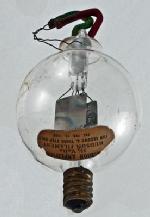
Audion_13-Hudson-fil
|
|
|||||||||||||||||||||||||||||||||||||
|
Hits: 1702 Replies: 0
de Forest, McCandless and the Hudson filament
|
|
|
Fin Stewart
30.Apr.17 |
1
From 1903 to late 1905, Lee de Forest was experimenting with his "Oscillation Responsive Device" - a Bunsen burner flame detector but he realised the flame was not stable in a draft. He decided to try obtaining a tube similar to the recently invented Fleming two electrode diode (in England) and he approached H. W. McCandless & Co (a miniature lamp manufacturer with a factory on 27th Street, New York), asking for some copies of a Fleming tube to be made. The resulting tubes had four volt carbon filaments and were fitted with candleabra screw (E12) bases. This was late in 1904 and carbon was the only type of incandescent lamp filament available in the U. S. at the time. de Forest carried out numerous experiments with these tubes. In Germany, Otto Feuerlein of the Siemens & Halske company in Berlin had deverloped a new type of lamp with a tantalum filament. This was in 1902. It is not recorded when this happened but early in 1905 a friend of McCandless bought back from Germany a tantalum lamp which he gave to the lamp maker. The tantalum lamp was much more efficient than the carbon lamp and McCandless thought he could use some tantalum in some of his lamps and also the 'Audions" he was making for de Forest. He subsequently broke the lamp and retained tantalum filament. This was a 110 volt lamp so there was approximately 15 cm of tantalum in the lamp. Mc candless succeeded in making small lamps with a 2 volt filament, as a side experiment and realised that tantalum could be adapted to the Audion. After the initial four volt carbon filament tubes were made, three more known developmental tubes were made with carbon filaments. It was difficult to use carbon filaments because of the current drain of the carbon. By the fall of 1906 when the first grid type Audions were made, they also had carbon filaments. By this time, McCandless had some tantalum but needed more for the filaments. He wrote to the Siemens & Halske company for an agreement that they could supply him with tantalum wire. This prove difficult, most likely because of patent problems. However shortly after this the General Electric Company was licensed by S & H to make their own tantalum lamps. McCandless was able to arrange a suitable agreement with GE for a limited supply of tantalum wire. Some tubes were made with the tantalum filament but the wire was prone to distorting and in some cases actually touched the grid of the tube. In 1907 the "sintered" or pressed tungsten filament was developed (also in Germany) and it was soon possible for the tubes to have the new filament. Tungsten was a small improvement over carbon but way short of tantalum in performance. One customer of McCandless was Walter G Hudson, a senior chemist with the Dupont organization. Exact dates are unknown but he discussed the tungsten filament performance with McCandless (presumably some time in 1907) and suggested that if the tungsten filament could be wrapped in tantalum wire, the performance would improve. The National Valve Museum in England has photographs of an Audion in its displays that shows a patent date 18th February 1908 and th words Hudson filament, all on a paper label. The patent, (no 879532A) relates to the Audion itself (in a suitable circuit) and not the Hudson filament. This is evident as Hudson applied for a patent on his wire would filament on February 19th, 1914. Patent No 1190412 was granted for this on July 11th, 1916. The illustration shows the filament (tungsten) with wire wrapping (tantalum). Page 2 of the patent text states that "The substance which performs the said electrodal function is, in its present instance, a tantalum wire or ribbon wound around the tungsten filament. Where suitable salts of the electrodal material are available, electroplating is a convenient method of applying the same to the filament." It seems that Hudson in his late patent application covered 1) the addition of tantalum wire to the filament and 2) his newer method of adding powdered tantalum (as a paste) to the filament. Use of the wound tantalum was thus discontinued. In all, several thousand Hudson filament Audions were made and sold, many to the US Military. References: 1) How Audions were built. G. J.Tyne - pages 27-29 Radio Craft January 1947 2) Saga of the Vacuum Tube, G. J. Tyne, published by Howard W. Sams & co Inc 1977 3) Nation Valve Museum (England) photo (Audion with Hudson filament) 4) The Electric Lamp Industry, A. A. Bright MacMillan & co, New York 1949, page 178 |
End of forum contributions about this tube
| Data Compliance | More Information |

